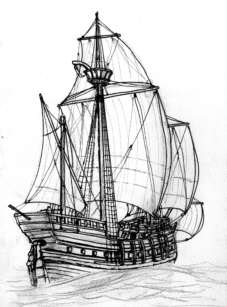In the 1970s a wreck from the 1540s was found north of Västervik on the Swedish east
coast. It is 23 m long and laying on 19 m depth. It was loaded with grain, tar, cinnabar, flintstone
and limestone. It was clinker built and is believed to have
carried three masts. Below is the English abstract from the final report.
Abstract
Definition of the problem:
 The
general objective is to gain further knowledge of the sailing merchantmen of the 16th century. The
research involves archaeological as well as interdisciplinary methods. No study of such a ship has
previously been made in Sweden. The problems are presented as a number of partial aims concerning
dating, naval technology analyses of hull and rig functions, contents of the cargo and its origin, as
shown by owner's marks registered in Hanseatic towns, and consequent conclusions of sea routes. Another
problem is the contents of the cargo in relation to the trade policy of the 1540's and 50's, during the
reign of Gustavus Vasa. The complex of problems also include the social strata aboard the ship, and the
living conditions of those on board. The overall purpose is to solve these partial problems.
The
general objective is to gain further knowledge of the sailing merchantmen of the 16th century. The
research involves archaeological as well as interdisciplinary methods. No study of such a ship has
previously been made in Sweden. The problems are presented as a number of partial aims concerning
dating, naval technology analyses of hull and rig functions, contents of the cargo and its origin, as
shown by owner's marks registered in Hanseatic towns, and consequent conclusions of sea routes. Another
problem is the contents of the cargo in relation to the trade policy of the 1540's and 50's, during the
reign of Gustavus Vasa. The complex of problems also include the social strata aboard the ship, and the
living conditions of those on board. The overall purpose is to solve these partial problems.
Theoretical and methodological bases:
The formation of theories in naval archaeology do not differ from archaeology as a whole, as for example inductive excavation with a deductive interpretation. Methodological bases are alike. Interdisciplinary methodology has vastly enriched the information flow through dendrochronology, C-14, osteology, macrofossil analysis, thermoluminescence, X-ray fluorescence, electronic underwater technology, naval technological examination of performance at Chalmers University of Technology and finally art-historical analysis. The artefact material provides the obvious and central basis of the formation of theories.
Source material:
The wreck was found outside Flatvarp, Östra Ed parish in Småland, in the south of Sweden. The source material consists of 1306 objects, put together in different object groups. The findings of the excavations have been studied for 15 years, partly on the excavation site, partly in institutions. Specially selected and recovered constructional parts form a basis for classification of the vessel, in relation to hull measures and mapping. The dendrochronological result was made up with typological elements. Conclusions from the artefact material are discussed with reference to existing literature. Written sources on the merchant vessel itself are practically non-existent.
Result:
The result gives a differentiated picture of a merchantman during the final period of the Hanseatic League. As regards classification, Ringaren is denominated a Baltic Sea carack.
by Nils Svenwall
The abstract is from:
Ett 1500-talsfartyg med arbetsnamnet Ringaren, Arkeologiska institutionen
(1994), Stockholms universitet, S-106 91 Stockholm, ISBN 91-7153-166-1
Akademisk avhandling för avläggande av filosofie doktorsexamen vid Stockholms Universitet, fredagen den
21 januari 1994 av NILS SVENWALL arkitekt, fil. kand.
Opponent Ar fil.dr. ARNE EMIL CHRISTENSEN, Oslo
Other literature:
- Marinarkeologisk Tidskrift 1/79
- Johan Rönnby & Jon Adams: Östersjöns sjunkna skepp (1994)
 Back to Nordic Underwater Archaeology
Back to Nordic Underwater Archaeology